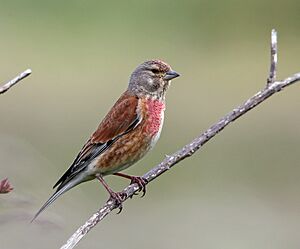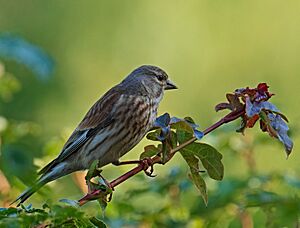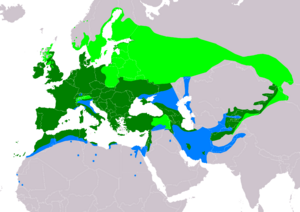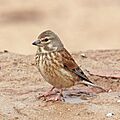Common linnet facts for kids
The common linnet (Linaria cannabina) is a small bird from the finch family. It's known for liking hemp and flax seeds. In fact, its scientific name, Linaria, comes from "linum," which is Latin for flax!
Quick facts for kids Common linnet |
|
|---|---|
 |
|
| Male in breeding plumage | |
 |
|
| Female | |
| Conservation status | |
| Scientific classification | |
| Genus: |
Linaria (bird)
|
| Species: |
cannabina
|
 |
|
| Range of L. cannabina Breeding Resident Non-breeding | |
| Synonyms | |
|
|
Contents
How Linnets Got Their Name
In 1758, a Swedish scientist named Carl Linnaeus gave the common linnet its first scientific name, Acanthis cannabina. Later, scientists moved it to a different group, or genus, called Linaria. This change happened after they studied the bird's DNA.
The name linaria comes from a Latin word meaning "linen-weaver," which is related to "flax." The word cannabina comes from the Latin word for hemp. Both names show how much these birds love seeds from plants like flax and hemp!
There are also several different types of common linnets, called subspecies, found in different parts of the world. For example, one type lives in Scotland, while others live in places like the Middle East or the Canary Islands.
What Linnets Look Like
The common linnet is a slender bird with a long tail. Its upper body is brown, and its throat is a dull white. The beak is grey.
During summer, male linnets have a grey neck, a red patch on their head, and a red chest. Female linnets and young birds don't have these red colors. Instead, their undersides are white, and their chests have streaky brown marks.
Where Linnets Live
Common linnets live and breed in Europe, parts of Asia, and North Africa. Some linnets stay in one place all year, but many from eastern and northern areas fly south for the winter. They sometimes even fly far out over the ocean! You can also find them in the Dominican Republic, where they were introduced by people.
Linnet Behaviour
Linnets like to build their nests in thick bushes in open areas, like heathlands or gardens. A female linnet usually lays four to seven eggs in her nest.
Outside of the breeding season, common linnets often gather in large groups. Sometimes, they even mix with other finches, especially near coasts.
These birds are known for their pleasant song, which includes fast trills and twitters.
Linnets mostly eat seeds, which they find on the ground or in low bushes. They also feed these seeds to their baby chicks. They enjoy small to medium-sized seeds from many different plants, like dandelions, thistles, and birch trees. They also eat a very small amount of Invertebrates (like insects).
Protecting Linnets
The number of common linnets in some places, like Britain, has been going down. This is mainly because of things like using too many herbicides (chemicals that kill plants) on farms. These chemicals reduce the amount of seeds available for the birds to eat. Also, removing too many bushes and trimming hedges too much can destroy their nesting places.
To help linnets, people can use better farming methods. This includes:
- Setting aside some land where plants can grow wild.
- Leaving fields unplowed after harvest so birds can find seeds.
- Creating areas along the edges of fields where wild plants can grow.
- Planting special crops that produce lots of small, oily seeds, like kale or mustard plant.
- Restoring meadows where different plants can grow.
- Keeping short, thick, thorny hedges and bushes where linnets can safely build their nests.
Images for kids









